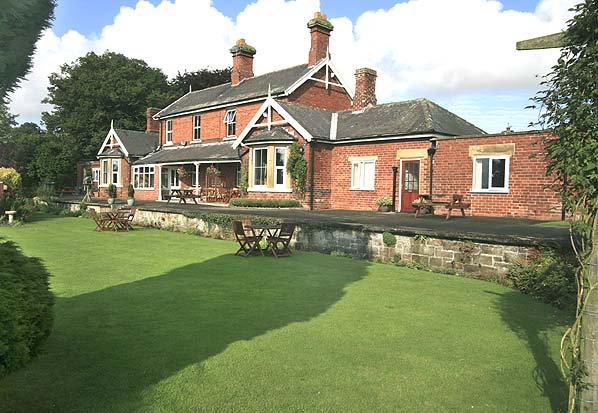
Station Name: SAWDON
|
| Date opened: | 1.5.1882 |
| Location: | East side of Ings Lane |
| Company on opening: | North Eastern Railway |
| Date closed to passengers: | 5.6.1950 |
| Date closed completely: | 5.6.1950 |
| Company on closing: | British Railways (North Eastern Region) |
| Present state: | The station is now private residence, the station buildings and platform are in excellent condition. |
| County: | Yorkshire |
| OS Grid Ref: | SE947817 |
| Date of visit: | 7.9.2008 |
Notes: Sawdon served the village of Brompton-by-Sawdon, it has been suggested that the station was so named to avoid confusion with Brompton near Northallerton, also in North Yorkshire. The map below shows the village as Brompton but Brompron-by-Sawdon (also the Parish name) is now the preferred name. Sawdon goods yard was sited on the down side of the line behind the station and had three sidings, it was the only station on the line to have an end dock, being able to handle furniture vans, motor cars and carriages. Also provided was a one ton crane, weighbridge, goods warehouse and cattle dock. The station got quite busy here during the Second World War, when the 11th armoured division took over a Cavalry Unit at nearby Wydale Hall. They also occupied Brompton Hall and armoured vehicles, guns and other equipment were carried by the railway.
There was an earlier proposal in 1864 for a line from Pickering running east along the north side of the Vale of Pickering as far as West Ayton where it would turn north along the Forge Valley to a junction with the proposed Scarborough - Whitby line at Scalby. Because the Scarborough - Whitby line was not built at this time, the Forge Valley line was not proceeded with.Work on the coast line finally started in 1872 and the Scarborough & Whitby company minutes on 4th November record a proposal to build the line along the Forge Valley from Ayton as a feeder for the Whitby line. The proposal was approved by the board at an estimated cost of £35,000. A Bill was put before parliament in 1873 but was later withdrawn following objections from Lord Londesborough who owned part od the proposed route.
Intermediate stations were built at Forge Valley (serving East and West Ayton), Wykeham, Sawdon, Snainton, Ebberston (Wilton until 1903) and Thornton Dale. Trains ran between Pickering and Scarborough, also calling at Seamer which had opened with former York and North Midland route to Scarborough in 1845. The line retained the earlier name of the The Forge Valley Line, it was single track throughout with a passing place at Snainton, the only station with two platforms running for 1614 miles from Seamer Junction to Mill Lane Junction south of Pickering where it joined the NER's lines from Rillington and Bishophouse Junction on the York - Darlington main line.
Services were four weekday trains each way; there was never a Sunday service and few excursions except for some to and from Helmsley. In 1928 the line became the first in the area with a regular Sentinel steam railcar service for passengers introduced by the LNER in an attempt to keep costs down. Railcars were considered suitable for this line as passenger traffic was light and there were no steep gradients The Sentinels were mechanically unreliable and struggled to cope with attachments such as horseboxes, commonly required on rural lines. All the stations except Wykeham had facilities to deal with livestock, and such agricultural produce comprised most of the freight on the line, although there was also stone from a quarry at Thornton Dale.
In June 1933 the LNER introduced camping coaches at a number of scenic stations in the area, two of these eventually came to the Forge Valley line with a single carriage being provided at Forge Valley and Thornton Dale. Passenger traffic on the Forge Valley line had always been light and by 1922 the service remained at 4 daily trains with an additional train on Thursday and three additional trains between Scarborough and Forge Valley. With the introduction of the steam railcars the service was increased to seven daily trains but after nationalisation it was clear that the service was no longer viable with the ever increasing popularity of the motor car post war. After only 68 years British Railways announced closure of the line to both passenger and freight traffic; despite somelocal objections the line was closed from 5th June 1950; the last train out of Scarborough was at 6.40 pm on Saturday 3rd June where a small crowd gathered with over 100 local people boarding the last train which was greeted by detonators at each station. The track between Seamer and Thornton Dale was lifted between 1952 and 1953. The final three miles of the line between Thornton Dale and Pickering remained open until 10th August 1964 to serve the stone quarry.
See also the Forge Valley Railway web site for a more detailed history of the line and more photographs. To see other stations on the Forge Valley Railway click on the station name: Seamer, Forge Valley, Wykeham, Snainton, Ebberston & Thornton Dale See alto other local lines: Malton & Driffield Junction Railway, Thirsk & Malton Railway (Malton - Pilmoor) & Gilling - Pickering |
old2.jpg) Sawdon station staff and a permament way gang pose for the camera in the first decade
Sawdon station staff and a permament way gang pose for the camera in the first decadeof the 20th century.
Photo from John Mann collection


old1.jpg)





7.jpg)
6.jpg)







 Home Page
Home Page